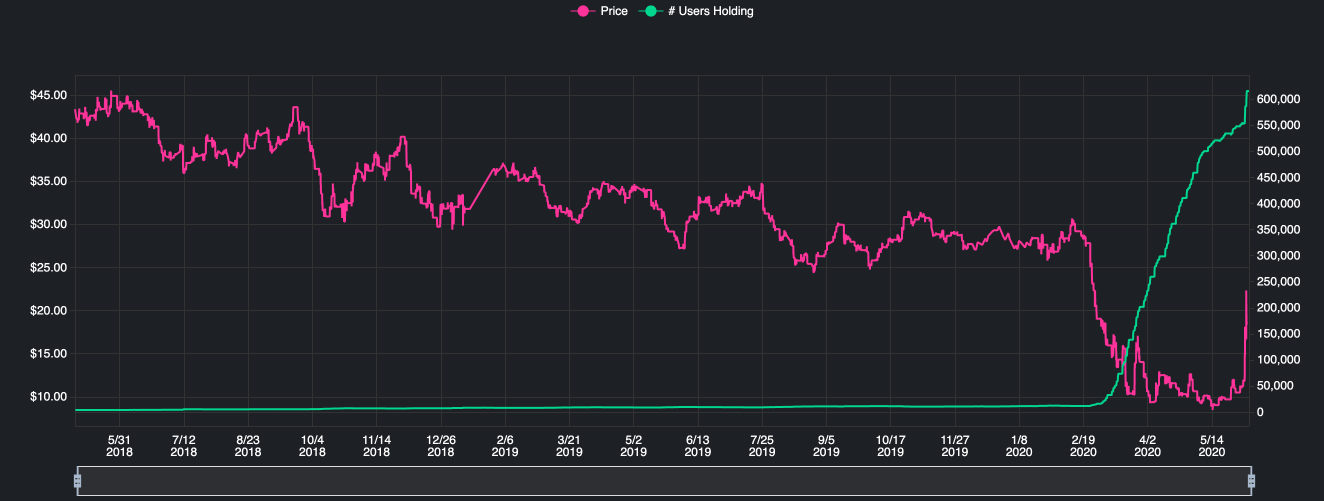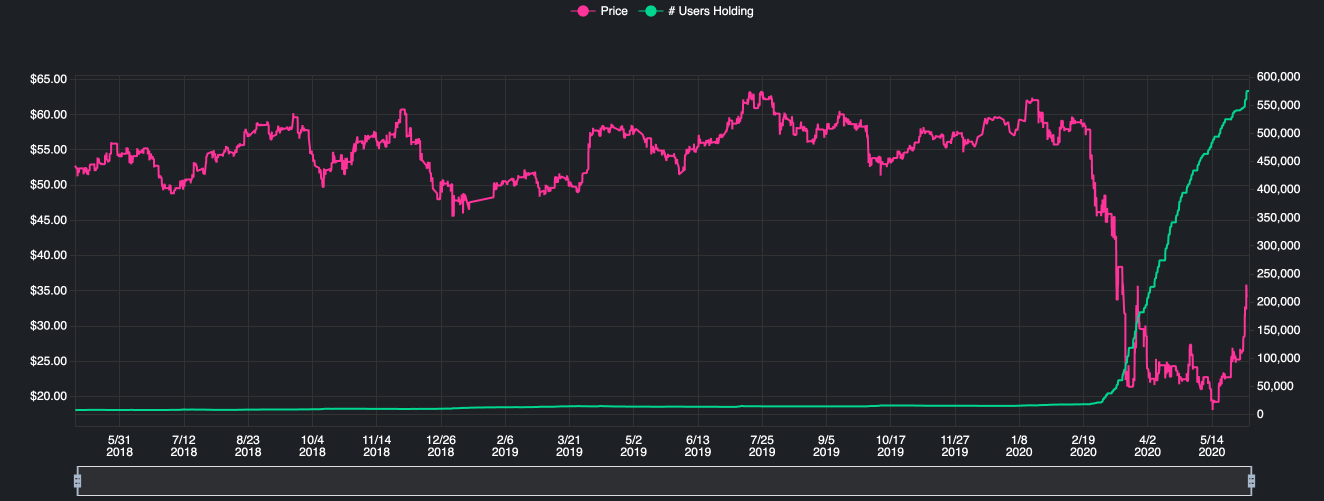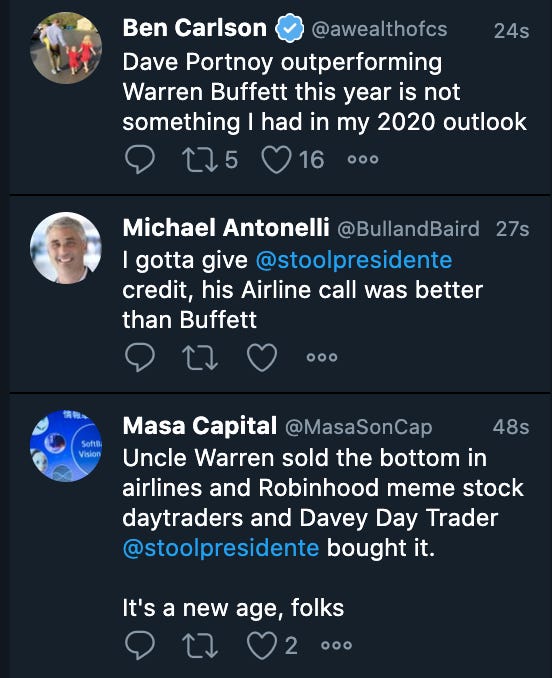“Buy low, sell high.”
Robinhood as a proving ground for what happens when everyone learns the same investing rule
An idea I keep coming back to is that everyone knows everything.
I’ve written about this idea in the meta-context of why newsletters work, why NBA teams shoot more threes, and why media outlets eventually all write the same stories.
Knowledge is a commodity. Whatever knowledge you have, assume many others have more. Whatever you don’t, remember it’s probably just a few Google searches away.
And so when a large group of people appear to quickly grok a trend or idea that was supposedly the domain of experts alone, I don’t think surprise should be the reaction. And certainly not scorn.
Right now, it appears that there is a new class of investors exerting some not-insignificant level of influence on stock prices. And it appears this class of investor all learned the same rule about what makes a good investor and have acted on that basis.
And that rule is buy low, sell high.
At the risk of being derailed by a detailed discussion of trend-following strategies and whether durable approaches for consistently beating the market are really available to investors, let us agree that “buy low, sell high” is the simplest, most widespread understanding the public has of “how to invest.”
I think a fair critique of this assertion is that it almost implies professional investors don’t know this. Which I do not think is true.
Professional money managers surely know this simple maxim. But the practicalities of professional investment management are what stands between the real-time execution of a sound idea and dumping your biggest positions at the market bottom.
My career in business media seems to have coincided with a veritable boom in content about investment psychology. It’s a sub-category of financial pontification that is at once informative and at the same time holds out a holier-than-thou pose that implies someone who’d done more reading would’ve known better. But no amount of Thaler is going to prevent capital calls. A few phone calls go the wrong way with a few too many clients and all of a sudden you’re a forced seller into a declining market. And it might not even take this much. Boss says sell, you sell. And so.
But in a world where everyone knows everything, it shouldn’t be all that shocking that it appears sports-betting-enthusiasts-turned-day-traders quickly picked up the investing world’s simplest idea and have applied it en masse.
A few weeks back, data from Goldman Sachs showed the rapid rise in new Robinhood accounts tracking the stock market higher.
This chart makes a strong argument that retail investors nailed the bottom. And further, that this rally is all about what’s happening at the retail level.


The free trading pioneered by Robinhood and now mimicked by just about every major investing platform creates the conditions for retail to be a significant bid in the market. That millions of small money, novice traders understood there was opportunity in the stock market after a 35% decline isn’t something to be lamented, but celebrated.
Marc Rubenstein at Net Interest estimates that retail’s share of market volumes in March and April were 40% higher than a year ago. The chart referenced above from Goldman would imply this number has continued to grow during the spring.
Data from Robintrack show that over the last week several airlines, a company that just filed for bankruptcy, and a stock that had been previously frozen because of massive accounting issues at the company were among the most popular additions to portfolios.
And the throughline on these names is pretty clean: the price of all these companies’ stocks had gone down a lot over the last few months.
Buy low, sell high.
And the charts that show portfolio additions against stock price bear this out. Again, this is not rocket science, this is just evidence that a public newly enthused about buying stocks and able to do so on the cheap is applying one simple rule.
Here’s American.

And Delta.

And Luckin.

We could go on like this. Or you can check the data for yourself.
So but we can clearly see that a certain subset of investors who are more involved in the market are applying the rule of buying low. Each of these charts show stocks that on a per-share price basis are significantly cheaper now than they were a few months ago. And these stocks’ popularity in portfolios on a mobile app that gamifies stock trading has followed as a result of the price falling.
Questions certainly abound. What happens when these investors sell? Will they sell? Will they sell high? Is there really enough new money out there to support this kind of retail enthusiasm over time? Will this be the source of a market meltdown in the months ahead?
These are all important, albeit unanswerable, questions.
But as Rubenstein outlines in his post arguing that trading is taking on a form of entertainment, there is data supporting the idea that many of these new entrants to the market are being redirected from the world of sports betting. A world that is on hold right now for obvious reasons.
So there is attention and capital available for capture and the stock market has caught a considerable portion of this customer base. As Rubenstein writes:
But a pivot from sports is a compelling explanation. The demographic of Robinhood’s customer base is similar to that of a sports bettor. Men aged 25-34 are the segment most likely to bet on sports on a regular basis. According to Deloitte 43% of North American men aged 25-34 who watch sports also bet on sports at least once per week, and that’s the same group that has flocked to Robinhood. The median age of a Robinhood customer has drifted up from 27 in 2017 to 31 now, and 80% of them are men.
Indeed, Robinhood’s interface makes the transition between sports betting and trading seamless. The app has been compared to a mobile game (“Charles Schwab, meet Candy Crush,” according to an NBC News report) which users check ten times a day or more.
Robinhood customers also appear to be attracted to stocks for the same reasons they are attracted to sports events. In its S-1 prospectus DraftKings, a sports betting company, says that it delivers “betting experiences designed for the ‘skin-in-the-game’ sports fan — the fan who seeks a deeper connection to the sporting events that he or she already loves.” A look inside Robinhood portfolios reveals the sorts of companies that customers no doubt have deep connections to. Outside of the ‘cheap’ stocks (Robinhood gives away a free share, priced between US$2.50 and US$10, to every new account holder) portfolios are stuffed full of Aurora Cannabis, Disney, Snapchat, Tesla, Twitter. (Very few banks and financial services companies are in there.) On the basis that their customers love sports betting, there’s something meta about DraftKings itself having worked its way into more Robinhood portfolios than practically any other stock over the past month.
Seen this way, Robinhood is the entity that has packaged the stock market as content for a new generation of investors which have both excess time and, apparently, at least enough excess cash to get involved.
In the run-up to the financial crisis, talking babies were apparently the kind of marketing trick that worked for the stock market’s target demo. During a pandemic, being free and on an iPhone is good enough.
At some point during Friday’s wild post-jobs report rally, Finance Twitter began to hand over the crown of the world’s most influential investor from Warren Buffett to Barstool Sports founder Dave Portnoy.
And, yes, much of this is in jest.
But there’s also something real happening here.
The simplest idea in investing has been fully democratized. And the idea seems to work.
Now, when sports are back on TV and life looks more like the Before Times, maybe some of this enthusiasm goes away. Maybe the Robinhood market boom of 2020 will look like the shitcoin boom of 2017-18.
At Yahoo Finance, we made plans for a crypto-only live event right at the coin market top. If the planning starts for a retail-only stock trading live event I’ll let you know the next top might be in.
In the meantime, I think it is important for professional investors and those who look carefully at markets to not only not dismiss this retail rally, but think seriously about what else fresh eyes on the world of investing might yet unearth.
The gap between sophisticated and unsophisticated market participants has never been narrower.
Because calling stocks “securities” and having a proprietary EV/EBIT ratio that lets you pick up “cigar butts” the market is overlooking doesn’t mean someone buying American Airlines on their phone is a moron and you’re an ancient scholar. Everyone already knows how great GM’s balance sheet is and the stock has also done nothing for almost a decade.
And so today it’s retail buying airlines when Buffett sells. Maybe tomorrow will be Robinhood types dunking on value shops and starting Twitter fights with Cliff Asness.
Personally, I can’t wait.
Thanks for reading I’m Late to This. If someone sent this your way, or you haven’t done so yet, sign up below so you never miss an issue. We publish every Sunday morning.
If you agree, disagree, or just want to engage on any of the topics discussed in this letter, reply to this email or hit me up on Twitter @MylesUdland.
Feedback is always welcome and highly encouraged.





